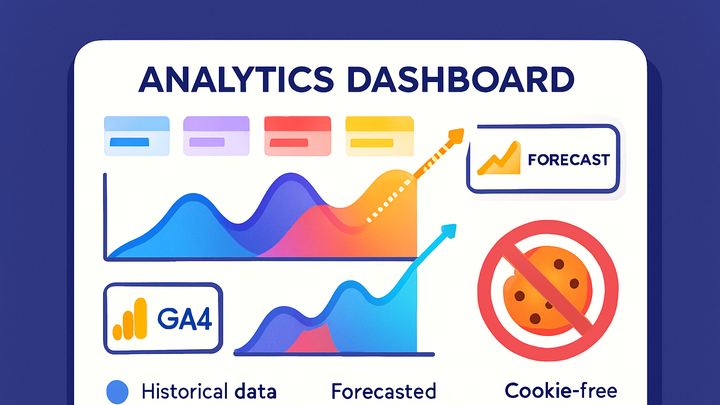Published on 2025-06-28T08:37:14Z
What is Forecasting in Analytics? Examples and Applications
Forecasting in analytics refers to the process of using historical data and statistical or machine learning models to predict future trends and metrics for websites, products, or business operations. It plays a vital role in:
- Strategic planning and budgeting
- Inventory and resource management
- Risk mitigation and customer retention
Common forecasting techniques include time series analysis (e.g., ARIMA, Exponential Smoothing), regression models, and machine learning algorithms. Analytics platforms like Google Analytics 4 (GA4) offer built-in predictive metrics such as purchase probability and churn probability, while privacy-focused tools like plainSignal provide cookie-free data collection and simple trend visualization. Reliable forecasting depends on high-quality data, continuous model validation, and understanding seasonal patterns and potential data biases.
Forecasting
Forecasting in analytics uses historical data and statistical or machine learning models to predict future trends for informed decision-making.
Why Forecasting Matters in Analytics
Forecasting provides actionable insights that help organizations plan strategically, allocate resources, and manage risk effectively.
-
Informed decision-making
Forecasting reveals future trends and patterns, enabling leaders to make data-driven decisions with confidence.
-
Resource optimization
By predicting demand and workload, companies can allocate budgets, inventory, and personnel more efficiently.
-
Risk mitigation
Forecast models can identify potential downturns or spikes, allowing for proactive risk management and contingency planning.
Forecasting Techniques and Models
Analysts use a range of statistical and machine learning methods to model data and project future values.
-
Time series analysis
Models data points collected at successive intervals to identify trends, seasonality, and cyclic behavior.
-
Arima
Combines autoregression, integration, and moving average components for flexible time series forecasting.
-
Exponential smoothing
Applies decreasing weights to past observations to quickly adapt to changes in the data pattern.
-
-
Regression analysis
Estimates relationships between variables to predict a continuous outcome based on one or multiple predictors.
-
Machine learning models
Leverages algorithms like Random Forests and Neural Networks to capture complex, non-linear patterns in data.
Implementing Forecasting in Google Analytics 4
GA4 integrates machine learning to offer predictive insights directly within its interface.
-
Enabling predictive metrics
Configure GA4 to collect user-centric data and activate predictive audiences and metrics in your property settings.
-
Key predictive reports
Utilize reports like purchase probability and churn probability to identify high-value or at-risk user segments.
-
Bigquery integration for custom forecasts
Export raw event data to BigQuery to run bespoke forecasting queries and machine learning models via SQL.
Forecasting with plainSignal
plainSignal provides a lightweight, cookie-free analytics solution with straightforward forecasting capabilities.
-
Privacy-centric data collection
plainSignal captures essential event data without cookies, ensuring full compliance with privacy regulations.
-
Visual forecast charts
The plainSignal dashboard offers simple trend visualizations and basic forecast projections built-in.
-
Example implementation
Add the following tracking code to your HTML to start collecting data and viewing forecasts in plainSignal:
-
Tracking code snippet
<link rel="preconnect" href="//eu.plainsignal.com/" crossorigin /> <script defer data-do="yourwebsitedomain.com" data-id="0GQV1xmtzQQ" data-api="//eu.plainsignal.com" src="//cdn.plainsignal.com/plainsignal-min.js"></script>
-
Best Practices and Common Pitfalls
Accurate forecasting demands rigorous data management, ongoing validation, and awareness of model limitations.
-
Maintain high-quality data
Ensure data cleanliness and consistency by handling missing values and outliers before modeling.
-
Continuous model validation
Regularly compare forecasted results against actual outcomes to detect drift and recalibrate models.
-
Avoid overfitting
Balance model complexity to prevent tailoring forecasts too closely to historical data, which harms future accuracy.
